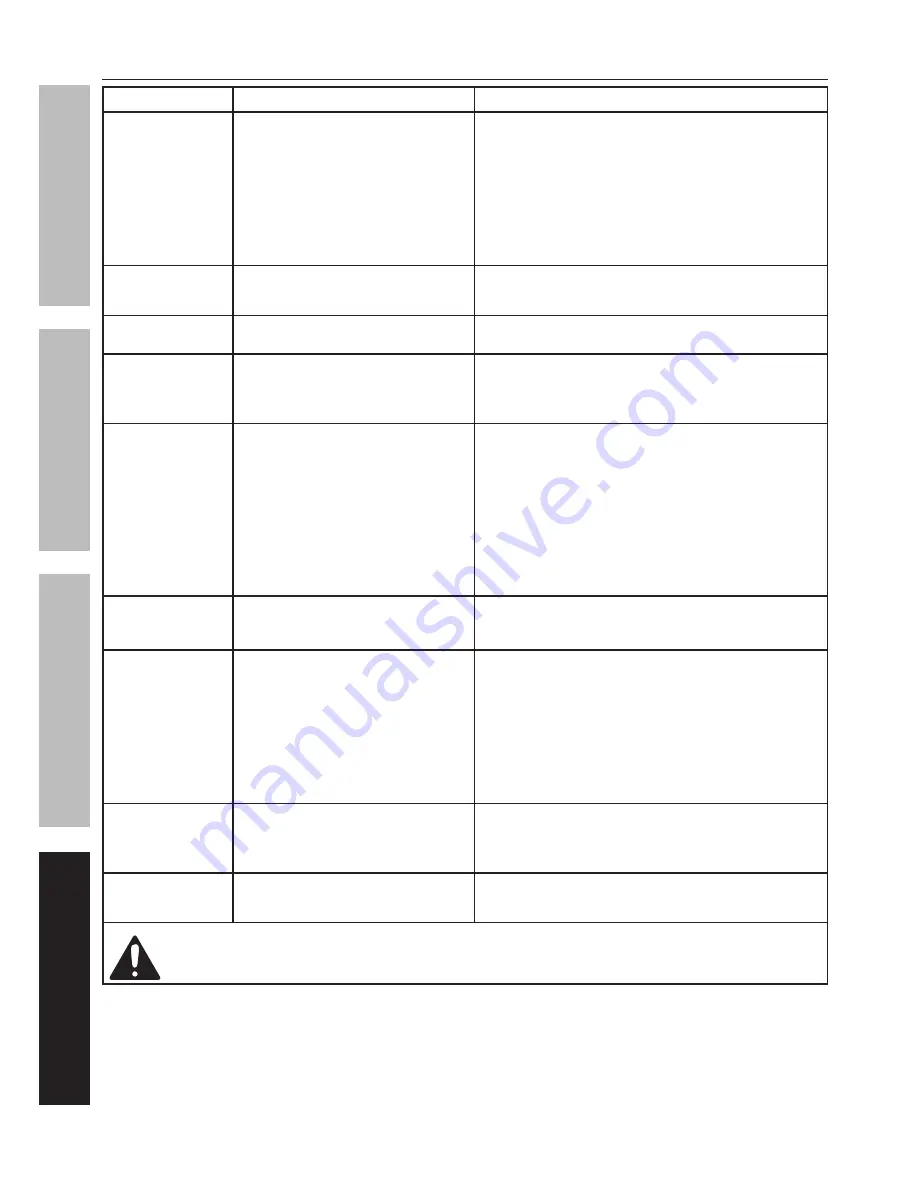
Page 16
For technical questions, please call 1-888-866-5797.
Item 61970
SAFET
y
Op
ERA
TION
M
AINTENAN
c
E
SETU
p
Troubleshooting
problem
possible causes
Likely Solutions
Tool will not start.
1. Cord not connected.
2. No power at outlet.
3. Tool’s thermal reset breaker
tripped (if equipped).
4. Internal damage or wear. (Carbon
brushes or switch, for example.)
1. Check that cord is plugged in.
2. Check power at outlet. If outlet is unpowered,
turn off tool and check circuit breaker.
If breaker is tripped, make sure circuit is right
capacity for tool and circuit has no other loads.
3. Turn off tool and allow to cool. Press reset button on tool.
4. Have technician service tool.
Tool operates slowly. Extension cord too long or
wire size too small.
Eliminate use of extension cord. If an extension cord
is needed, use one with the proper diameter for its
length and load. See
Table A
on page 3.
Performance
decreases over time.
1. Accessory dull or damaged.
2. Carbon brushes worn or damaged.
1. Keep cutting accessories sharp. Replace as needed.
2. Have qualified technician replace brushes.
Excessive noise
or rattling.
1. Internal damage or wear. (Carbon
brushes or bearings, for example.)
2. Belt too loose (slipping) or
too tight (bearing damage).
1. Have technician service tool.
2. Properly tension belt.
Overheating.
1. Forcing machine to work too fast.
2. Accessory misaligned.
3. Accessory dull or damaged.
4. Blocked motor housing vents.
5. Motor being strained by long or
small diameter extension cord.
1. Allow machine to work at its own rate.
2. Check and correct accessory to fence
and/or table alignment.
3. Keep cutting accessories sharp. Replace as needed.
4. Wear ANSI-approved safety goggles and
NIOSH-approved dust mask/respirator while
blowing dust out of motor using compressed air.
5. Eliminate use of extension cord. If an extension cord
is needed, use one with the proper diameter for its
length and load. See
Table A
on page 3.
Wood burns at
ends when cut.
1. Dirty Blade.
2. Material is binding.
1. Clean Blade using blade cleaner or mineral spirits.
2. Check position of work material on Table. Material must
be flat, flush against Fence and supported on ends.
Material frays
or chips out.
1. Finished side is down.
2. Blade chipped or dull.
3. Blade inappropriate for material.
4. Material is unsupported.
1. Keep finished side of material up or facing operator.
Bottom and back side are prone to chip out.
2. Check for damaged teeth. Sharpen or replace blade.
3. Check blade manufacturer’s recommendations for
material being cut. For cross cutting hard wood and for
precision cuts use a thin kerf blade with 60 or more teeth.
4. Use a thin piece of scrap material, such as
1/4″ plywood, underneath or behind the material to
support the edges of the material as it is being cut.
Blade binds, slowing
or stopping saw.
1. Material is misaligned on the saw
or ends are not supported.
2. Material is wet, contaminated or
inappropriate blade is being used.
1. Material must be flat on table, flush against
the fence and supported on both ends.
2. Check condition of material and check
compatibility of blade to material.
Blade does not
cut completely
through workpiece.
1. Depth Stop setting in use.
2. Depth Stop set too shallow.
1. Move Depth Stop to right to disengage.
2. Adjust Depth Stop Bolt for desired depth of cut.
Follow all safety precautions whenever diagnosing or servicing the tool.
Disconnect power supply before service.
Summary of Contents for 61970
Page 1: ......





































